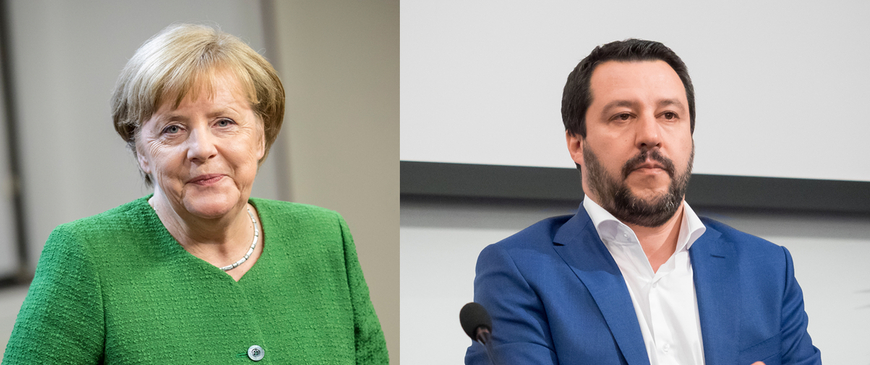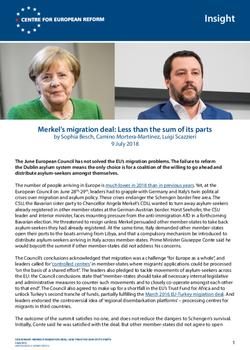
Merkel's migration deal: Less than the sum of its parts
The June European Council has not solved the EU’s migration problems. The failure to reform the Dublin asylum system means the only choice is for a coalition of the willing to go ahead and distribute asylum-seekers amongst themselves.
The number of people arriving in Europe is much lower in 2018 than in previous years. Yet, at the European Council on June 28th-29th, leaders had to grapple with Germany and Italy’s twin political crises over migration and asylum policy. These crises endanger the Schengen border free area. The CSU, the Bavarian sister party to Chancellor Angela Merkel’s CDU, wanted to turn away asylum-seekers already registered in other member-states at the German-Austrian border. Horst Seehofer, the CSU leader and interior minister, faces mounting pressure from the anti-immigration AfD in a forthcoming Bavarian election. He threatened to resign unless Merkel persuaded other member-states to take back asylum-seekers they had already registered. At the same time, Italy demanded other member-states open their ports to the boats arriving from Libya, and that a compulsory mechanism be introduced to distribute asylum-seekers arriving in Italy across member-states. Prime Minister Giuseppe Conte said he would boycott the summit if other member-states did not address his concerns.
The Council’s conclusions acknowledged that migration was a challenge "for Europe as a whole", and leaders called for ‘controlled centres’ in member-states where migrants’ applications could be processed "on the basis of a shared effort". The leaders also pledged to tackle movements of asylum-seekers across the EU: the Council conclusions state that "member-states should take all necessary internal legislative and administrative measures to counter such movements and to closely co-operate amongst each other to that end". The Council also agreed to make up for a shortfall in the EU’s Trust Fund for Africa and to unlock Turkey’s second tranche of funds, partially fulfilling the March 2016 EU-Turkey migration deal. And leaders endorsed the controversial idea of ‘regional disembarkation platforms’ – processing centres for migrants in third countries.
The outcome of the summit satisfies no one, and does not reduce the dangers to #Schengen’s survival.
The outcome of the summit satisfies no one, and does not reduce the dangers to Schengen’s survival. Initially, Conte said he was satisfied with the deal. But other member-states did not agree to open up their ports to boats reaching Italy, or to a compulsory redistribution mechanism. Additionally, it soon became clear that no member-state was willing to host ‘controlled centres’ on its territory, with French President Emanuel Macron and Spanish Prime Minister Pedro Sánchez rejecting the idea. As a result, the backlash against the deal has grown in Italy. Opposition politicians claim that the government has completely failed to achieve its aims, and Interior Minister Matteo Salvini has distanced himself from the deal.
After the summit, Merkel announced that she had secured the support of a number of member-states, including frontline countries Greece and Spain, to sign bilateral deals that allow Germany to return asylum-seekers to the countries that first registered them. She has since won the support of both the CSU and the Social Democrats (SPD), her other coalition partner, for the offer she brought back from the Council. But serious questions remain over the implementation of the deal. Italy – the country from which many previously registered asylum-seekers travelled to Germany – does not appear to be willing to take them back. If that is the case, Merkel is planning to refuse entry to asylum-seekers who travel from Italy through Austria, leaving Vienna to deal with them (and encouraging Austria to conduct more checks on its border with Italy). The patchy deal has taken the heat out of German domestic politics for now – Merkel has managed to offer Seehofer a way to back down from his demands and thereby avoided the breakup of her coalition, and she has even won the support of her other coalition partner, the Social Democrats, for her plan. But she has come closer than ever before to saying one thing in Brussels and another in Berlin, risking her credibility both in Europe and at home.
#Merkel has come closer than ever before to saying one thing in Brussels and another in Berlin.
In theory, neither the issue of asylum-seekers moving around the EU, nor the number of arrivals in Italy and Spain justify the political drama. Between January and April 2018, Germany successfully returned 15,000 asylum-seekers to other member-states, out of a total of 21,500 requested returns. Berlin estimates that it will send back 5-10 asylum-seekers per day under the new deal. And while Italy did have ample reason to complain about a lack of European solidarity with its heavy migration burden in past years, the number of arrivals has fallen significantly since its 2017 peak: there have been fewer than 17,000 arrivals in 2018 compared to almost 84,000 over the same period of 2017.
However, while the number of new arrivals has fallen, 1.8 million migrants entered the EU between 2014 and 2017, and many asylum cases remain to be dealt with, which keeps the issue in the headlines. Applying for asylum can be a lengthy process: it takes an average of 400 days to reach just an initial decision in Italy, and it can take much longer to reach a final one. And, if applicants are rejected and issued with an expulsion order, member-states often find it difficult to send them home: in 2017, member-states ordered 516,000 people to leave the EU, but only returned 211,000.
Moreover, the rhetoric of the CSU and Italy’s League resonate with voters because they are able to capitalise on a perception that migration is an epochal challenge for Europe as populations increase in sending countries. Indeed, the working-age population of Sub-Saharan Africa is projected to triple to 1.25 billion in 2050. Evidence shows that emigration from poorer countries rises as their economies develop, reaching a peak at a GDP per capita of $7,000-$8,000 – suggesting that managing migration will be a challenge for decades to come.
The political forces that are pushing Rome and the CSU to take a hard stance are unlikely to disappear. This time, the majority of the CDU rallied around Merkel to defend her against the CSU. But the AfD continues to put pressure on the right wing of the CDU/CSU. Merkel’s balancing act – between European solidarity and domestic pressure to act unilaterally – is not over. Salvini, for his part, is determined to make as much political capital from migration as possible. His approach is working: the League’s support has risen to 30 per cent – on a par with its coalition partner, the Five Star Movement. And surveys suggest that two-thirds of Italians support his stance on migration. As long as so many continue to think that the EU does not show Italy enough solidarity, Salvini’s popularity is unlikely to suffer, and his approach is unlikely to change.
The Schengen border-free area will continue to be at risk unless European leaders reform the Dublin asylum system, which mandates that frontline member states are responsible for processing most claims and returning failed applicants. (Under the system, asylum-seekers must claim asylum in the first EU country they enter.) This fuels a feeling of abandonment in front-line countries, while the perception that front-line countries are not living up to their obligations fuels nativism across the EU. Both trends threaten Schengen. Two ideas have been put forward to unblock the EU’s asylum system standstill: processing centres outside the EU, and similar centres inside the EU, from which asylum-seekers would be distributed across member-states. It is only the latter that can possibly work (although it is hardest to agree politically).
Processing centres outside the EU have not been made to work so far and probably never will be.
Processing centres outside the EU, where the applications of asylum-seekers would be looked at, so that successful ones are sent to Europe, while failed applicants are returned, are an old idea. They have not been made to work so far and probably never will be. First, it is unclear where they could be set up. They would have to be hosted in a stable and safe country, but no such country has yet agreed to host them – why should they deal with Europe’s migration problems? Third countries also fear such centres could be a pull factor for migrants elsewhere, who may end up being stranded in their territory for years. Second, it is unclear on what legal basis asylum claims would be evaluated, as the EU does not have a fully harmonised set of asylum laws. Third, which member-states would take in those whose claims were accepted? Many EU countries dislike the compulsory quota system they agreed to in 2015 and few have complied with it.
It would be very difficult politically to establish processing centres in the EU. The distribution of asylum-seekers could not be done in a binding way across all member-states, as many Central European member-states would refuse to take part. And Germany, France and Spain have so far shown limited enthusiasm for the burden-sharing it would entail. But if a coalition of willing member-states emerged it is possible to imagine a system where all migrants disembarking in Italy, Greece and Spain would be registered and then some would be automatically distributed to other member-states to have their asylum applications processed. The purpose of these ‘controlled centres’ is to complement the existing ‘hotspots’ - facilities that were set up in Greece and Italy to receive, identify and register asylum-seekers– with a system to share the burden of processing their applications. Such a system would go a long way towards defusing Italian grievances. It would also help ease friction between member-states about the movement of asylum-seekers: frontline states would no longer be responsible for processing all those who arrive, and would be more willing to take back some asylum-seekers.
The EU will need to make a choice: either it accepts that the Dublin system has never worked and never will, and replaces it with new rules, perhaps relying on a handful of willing member-states acting on a voluntary basis; or it tries to muddle through periodic crises. The latter route means more internecine squabbling, which could result in the loss of one of the EU’s most cherished achievements: the Schengen area. The only real alternative is to balance border controls and legal migration routes, creating partnerships to manage migration with third countries. Better to act now.
Sophia Besch is a research fellow, Camino Mortera-Martinez is a senior research fellow and Luigi Scazzieri is a research fellow at the Centre for European Reform.


Comments
I see little discussion on how to 'convince' mainly Eastern member states to honor their commitments, which raises the question in my mind as to why this is not dealt with in the budgetary structure of support payments?
Their failure could reduce their access to EU funding as a generality, or it could be a specific funding be applied to support each migrant taken in so that those taking the most would receive greater support.
This seems to be the basis of the deal with Turkey; why would it not be suitable for Hungary et al?
The condition of the support accommodation should be a factor within the financing made available, such as extra funds for schooling (of both children and adults) - and, as needed in Greece, an added support so that impoverished citizens of the accepting state get a percentage of similar care so they are not overtaken by the immigrants.
Add new comment